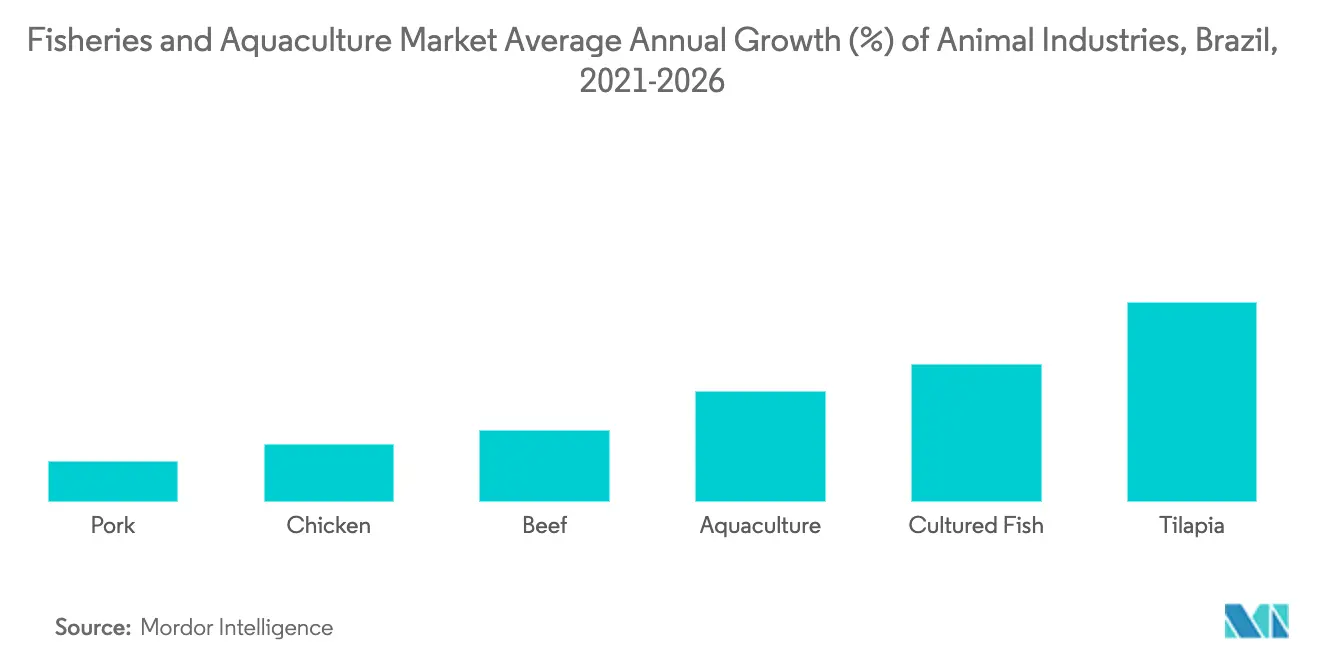Brazil Fisheries and Aquaculture Market Size

| Study Period | 2019 - 2029 |
| Base Year For Estimation | 2023 |
| Forecast Data Period | 2024 - 2029 |
| Market Size (2024) | USD 149.01 Billion |
| Market Size (2029) | USD 176.97 Billion |
| CAGR (2024 - 2029) | 3.50 % |
Major Players*Disclaimer: Major Players sorted in no particular order |
Brazil Fisheries and Aquaculture Market Analysis
The Brazil Fisheries and Aquaculture Market size is estimated at USD 149.01 billion in 2024, and is expected to reach USD 176.97 billion by 2029, growing at a CAGR of 3.5% during the forecast period (2024-2029).
Aquaculture is one of the largest sectors in Brazil, with more than 80.0% of aquaculture is fresh-water aquaculture.
The country is focusing on the fisheries and aquaculture sector, primarily due to the rising interest among investors, both, at domestic and global levels.
Currently, Brazil is the second-largest aquaculture producer in the Latin American and Caribbean region. While Brazil still depends on seafood imports to meet domestic demand, domestic aquaculture production may soon outcompete imported seafood.
Brazil Fisheries and Aquaculture Market Trends
This section covers the major market trends shaping the Brazil Fisheries & Aquaculture Market according to our research experts:
Growth in Seafood and Meat Consumption
Brazil is a major player in the aquaculture sector as well as seafood market regionally and globally. With increasing annual population of the country, it is the largest country in both South and Central America and the world's fifth-largest country, in terms of area and population. Currently, Brazil is the second largest aquaculture producer in the Latin American and Caribbean region. Currently, Brazil is the second largest aquaculture producer in the Latin American and Caribbean region. The growing opulation and the trend towards a healthy, high protein diet is leading to higher meat consumption which in turn is driving the market. While the country still depends on seafood imports to meet domestic demand, domestic aquaculture production may soon out compete imported seafood.
Brazil emerged as one of the potential countries for the expansion of the fisheries and aquaculture sector. Tilapia fishes are projected to register the fastest CAGR over the forecast period, followed by cultured fishes. The stakeholders in the value chain of fisheries and aquaculture are primarily focusing on fishing operations, like fish feed production, vaccines, medication, genetics, and supply of equipment and services.

Tilapia Dominates the Fishes Segment
According to the Brazilian Aquaculture Association (PeixeBR), tilapia fish accounts for 55.4% of the total domestic farmed fish output as of 2017. Furthermore, the country is ranked fourth, in terms of production of tilapia, following China, Indonesia, and Egypt.
Carps accounted for more than 70% of the non-native species. In the North and Northeast regions, native species and tilapia are the main cultured species, while in the South, Middle West and Southeast regions, tilapia, carp and catfish farms predominate. Polyculture farms utilising carp are present in almost every State and carp is currently the major fish species farmed in Brazil. A semi-intensive system using natural fertilization or integration with pig breading is a common culture pattern in the South region. The Brazilian aquaculture sector registered a growth of 4.5%, between 2016 and 2019.

Brazil Fisheries and Aquaculture Market Report - Table of Contents
1. INTRODUCTION
- 1.1 Study Assumptions and Market Definition
- 1.2 Scope of the Study
2. RESEARCH METHODOLOGY
3. EXECUTIVE SUMMARY
4. MARKET DYNAMICS
- 4.1 Market Overview
- 4.2 Market Drivers
- 4.3 Market Restraints
5. MARKET SEGMENTATION (Production Analysis, Consumption Analysis by Value & Volume, Import Analysis by Value & Volume, Export Analysis by Value & Volume)
-
5.1 Type
- 5.1.1 Unprocessed
- 5.1.1.1 Fresh/ Chilled
- 5.1.1.2 Frozen
- 5.1.2 Processed
6. REGIONAL ANALYSIS
- 6.1 PESTLE Analysis
- 6.2 Value/Supply Chain Analysis
- 6.3 Government Regulations and Policies
7. MARKET OPPORTUNITIES AND FUTURE TRENDS
8. AN ASSESSMENT OF COVID-19 IMPACT ON THE MARKET
** Subject To AvailablityBrazil Fisheries and Aquaculture Industry Segmentation
The report provides an analysis of various aspects of the Brazilian fisheries and aquaculture sector. The study includes an overview of the market dynamics, primarily related to production, consumption, import, and export of fishes and invertebrates. The market has been segmented on the basis of type, along with an in-depth analysis of sub-segments, such as fresh/chilled, frozen, and processed fish. The report identifies key factors that are instrumental in changing the market scenario, exploiting new opportunities, and gaining competitive edge.
| Type | Unprocessed | Fresh/ Chilled |
| Frozen | ||
| Type | Processed |
Brazil Fisheries and Aquaculture Market Research FAQs
How big is the Brazil Fisheries and Aquaculture Market?
The Brazil Fisheries and Aquaculture Market size is expected to reach USD 149.01 billion in 2024 and grow at a CAGR of 3.5% to reach USD 176.97 billion by 2029.
What is the current Brazil Fisheries and Aquaculture Market size?
In 2024, the Brazil Fisheries and Aquaculture Market size is expected to reach USD 149.01 billion.
What years does this Brazil Fisheries and Aquaculture Market cover, and what was the market size in 2023?
In 2023, the Brazil Fisheries and Aquaculture Market size was estimated at USD 143.97 billion. The report covers the Brazil Fisheries and Aquaculture Market historical market size for years: 2019, 2020, 2021, 2022 and 2023. The report also forecasts the Brazil Fisheries and Aquaculture Market size for years: 2024, 2025, 2026, 2027, 2028 and 2029.
Brazil Fisheries and Aquaculture Industry Report
Statistics for the 2024 Brazil Fisheries and Aquaculture market share, size and revenue growth rate, created by Mordor Intelligence™ Industry Reports. Brazil Fisheries and Aquaculture analysis includes a market forecast outlook to 2029 and historical overview. Get a sample of this industry analysis as a free report PDF download.



